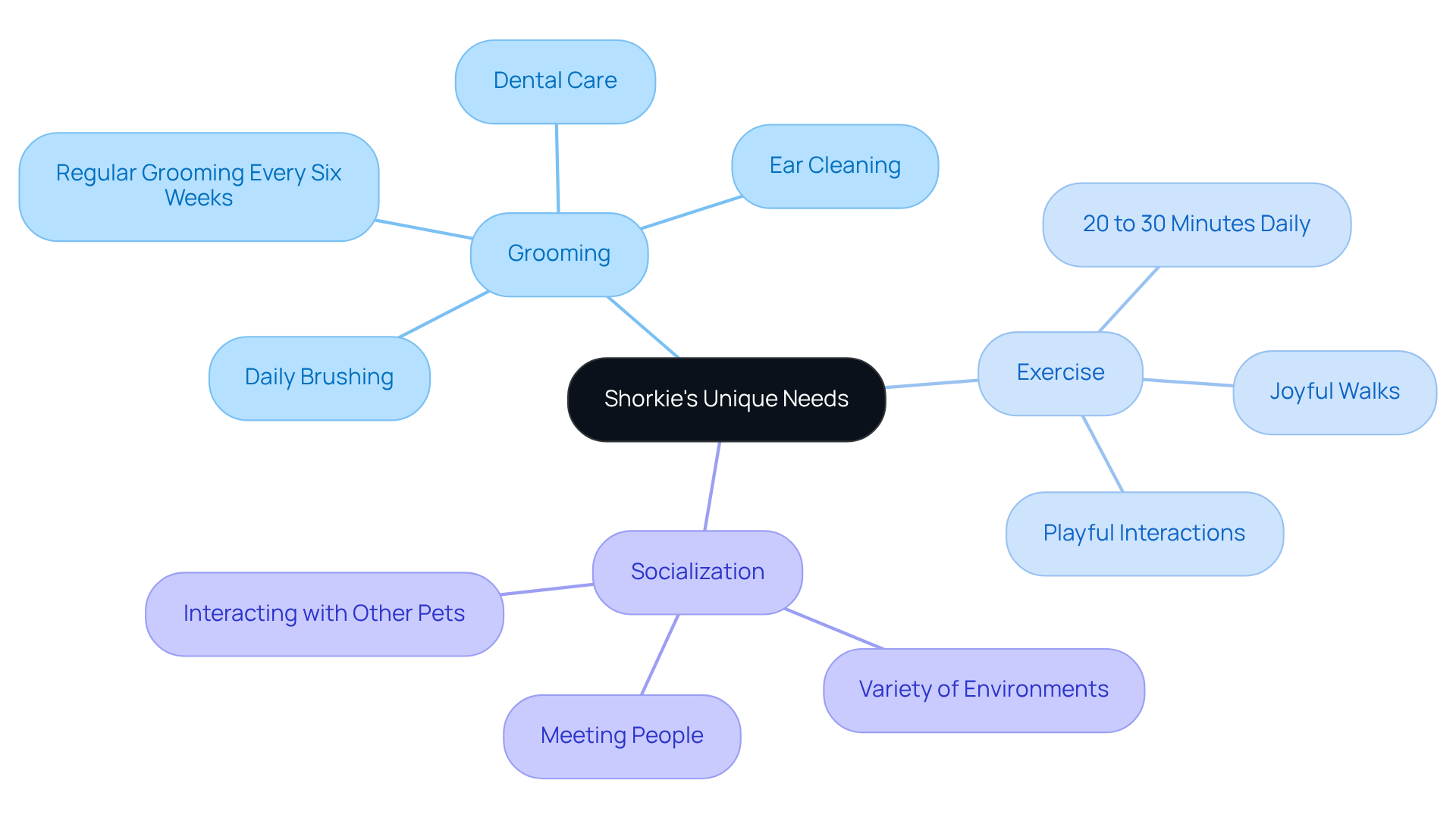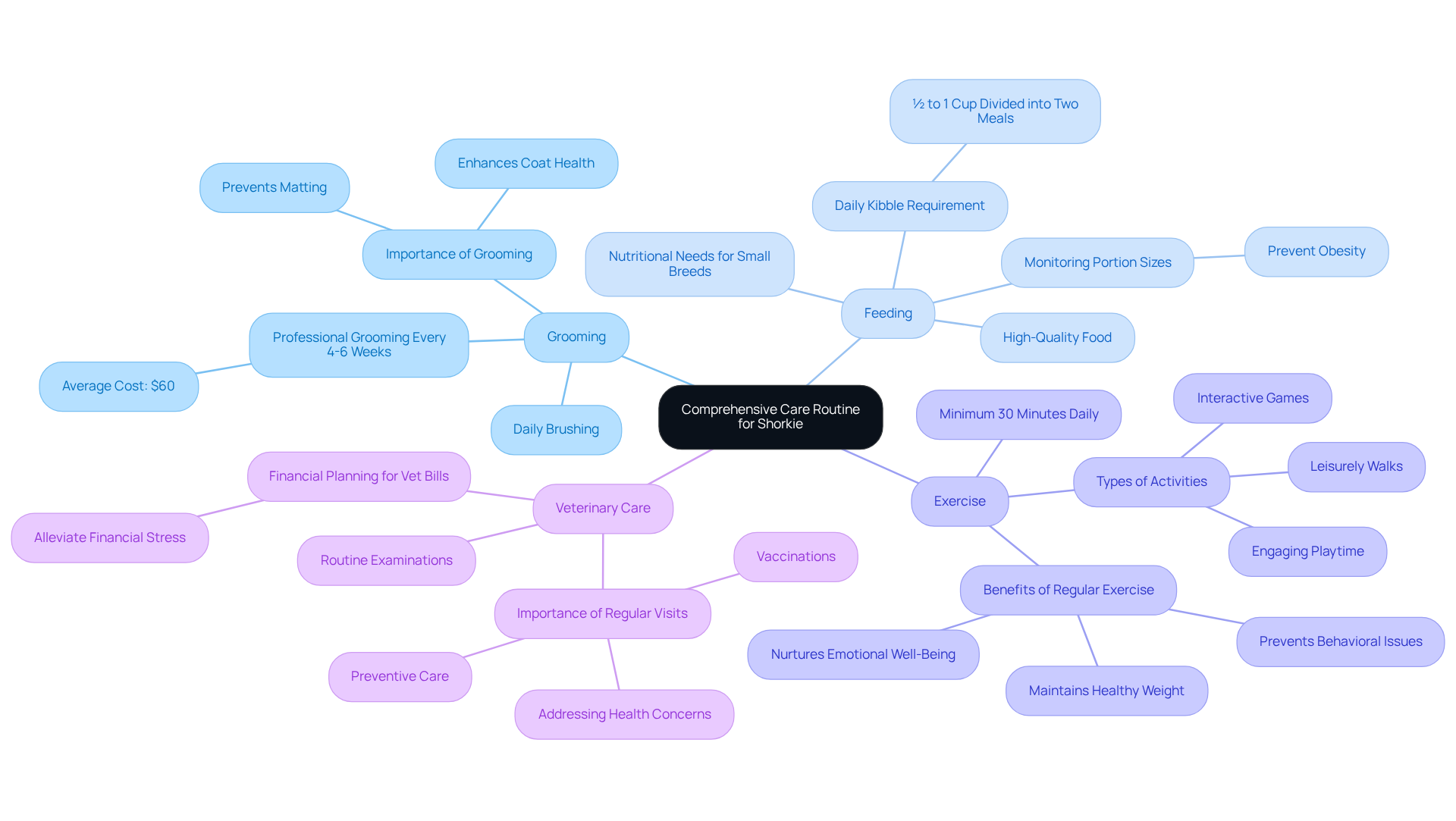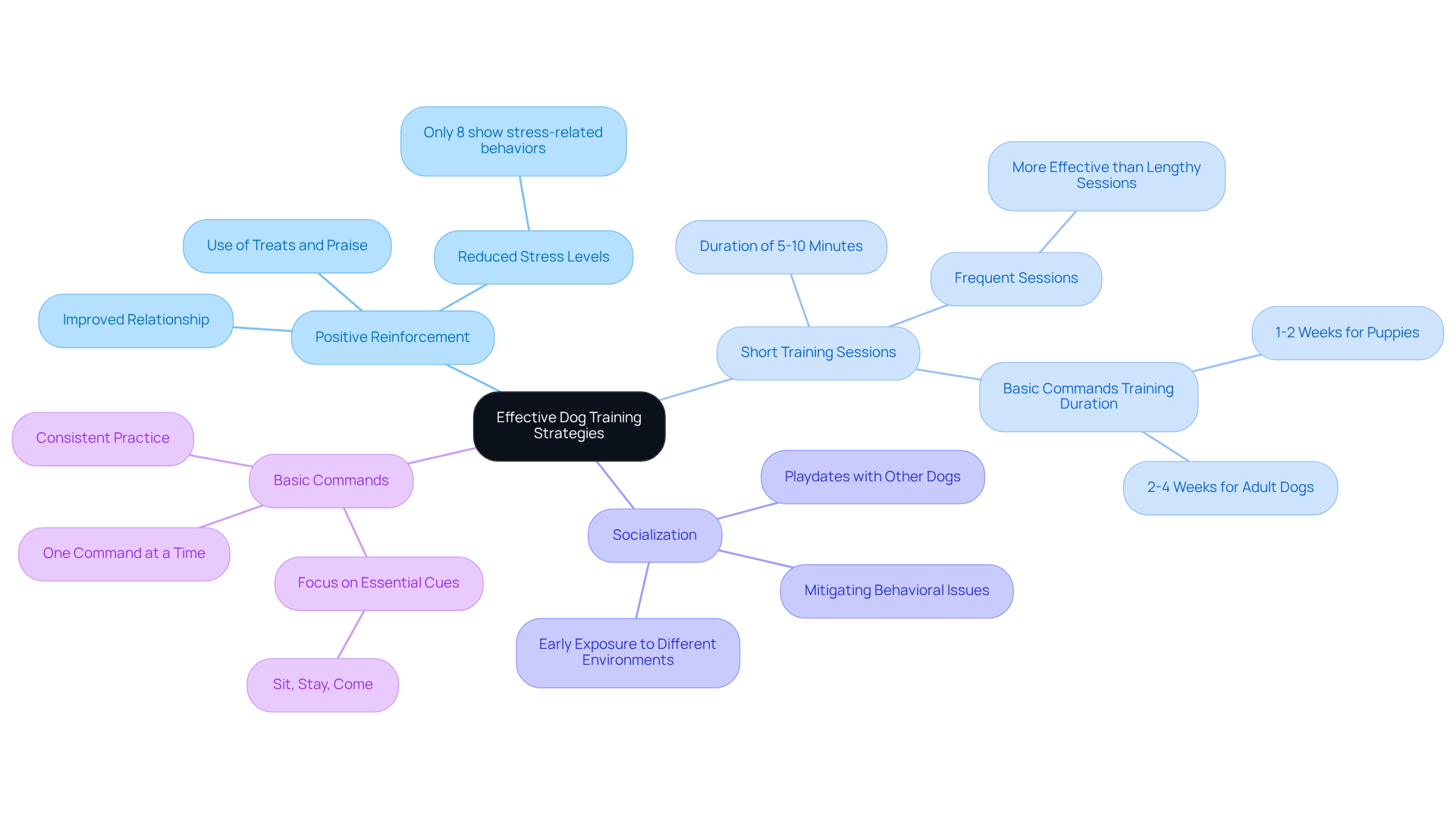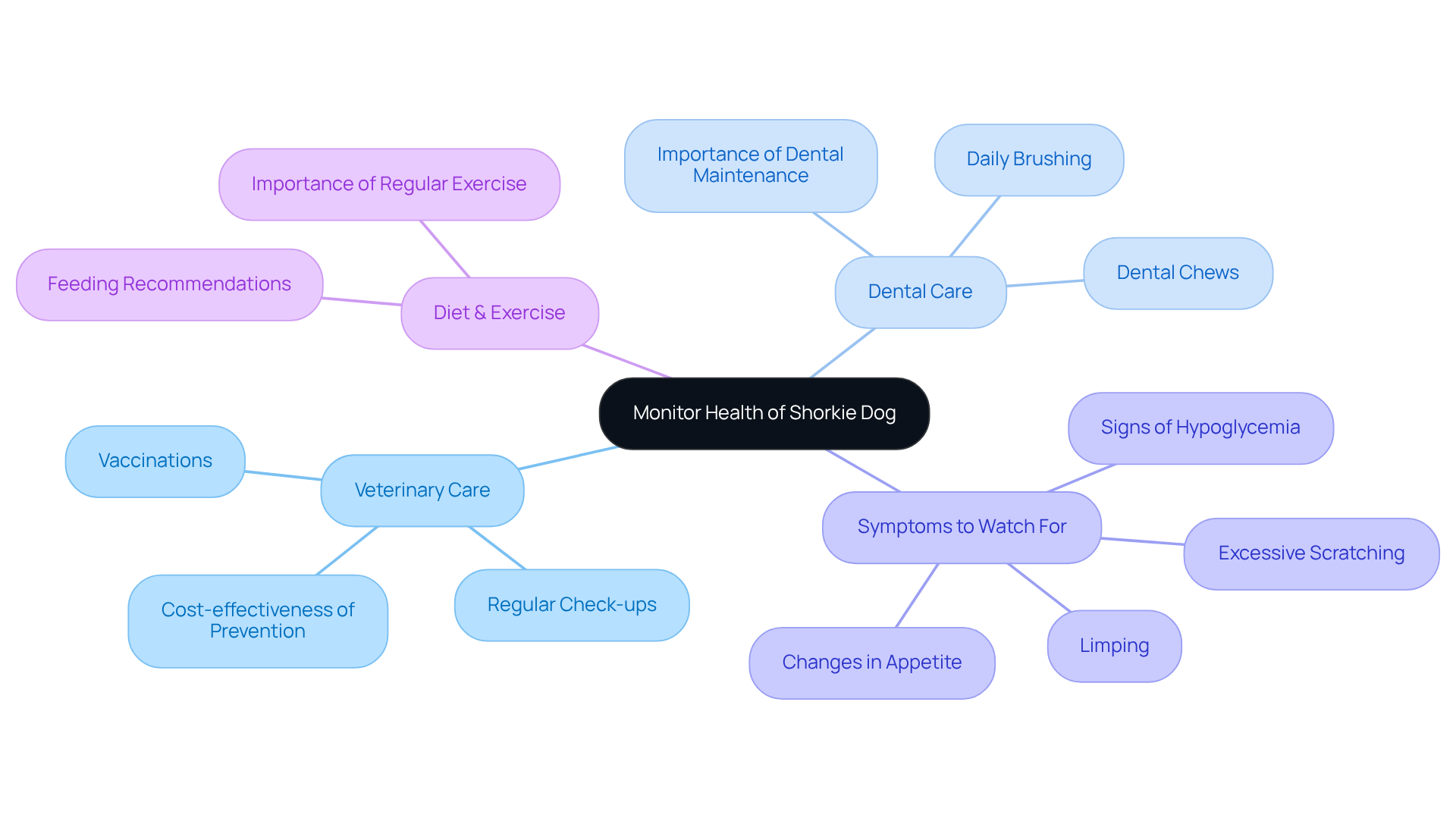
4 Steps to Care for Your Shorkie Dog Effectively
Overview
This article lovingly outlines four essential steps for effectively caring for your Shorkie dog, emphasizing the importance of:
- Grooming
- Exercise
- Socialization
- Health monitoring
Each step is accompanied by thoughtful recommendations that highlight the significance of:
- Daily brushing
- Regular exercise routines
- Early socialization practices
- Proactive veterinary care
These nurturing actions are vital for ensuring your furry friend’s overall well-being and happiness, allowing you to create a fulfilling life together.
Introduction
Caring for a Shorkie dog goes beyond mere affection; it requires a deep understanding of their unique needs. This charming blend of Yorkshire Terrier and Shih Tzu flourishes within a structured routine that encompasses:
- Grooming
- Exercise
- Socialization
By exploring the essential steps of Shorkie care, pet owners can cultivate a nurturing environment that fosters both health and happiness. Yet, what challenges might surface as you strive to balance these diverse needs while ensuring a joyful companionship? It’s crucial to recognize the emotional weight of these responsibilities, as they directly impact your beloved pet’s well-being.
Understand Your Shorkie’s Unique Needs
A shorkie dog, which is a delightful blend of Yorkshire Terrier and Shih Tzu, is a small, energetic companion that thrives on love and attention. As a devoted pet owner, you understand that their unique needs require thoughtful consideration in grooming, exercise, and socialization. By addressing these aspects, you can ensure a happy and healthy life for your furry friend.
-
Grooming: With their long, silky coats, Shorkies need daily brushing to prevent tangles and mats. Regular grooming sessions, ideally every six weeks, not only help maintain their coat’s condition and appearance but also foster a bonding experience between you and your pet. Additionally, routine dental care and ear cleaning are vital to prevent health issues, ensuring your beloved companion stays in top shape.
-
Exercise: These lively dogs require at least 20 to 30 minutes of exercise each day, which can include joyful walks or playful interactions. Engaging in regular physical activity not only keeps them fit but also alleviates potential behavioral issues that may arise from boredom or anxiety. Remember, a happy shorkie dog is a well-exercised shorkie dog.
-
Socialization: Early socialization is essential for Shorkies. By introducing them to a variety of environments, people, and other pets, you help build their confidence and ensure they grow into well-adjusted companions. This nurturing approach will make a significant difference in their behavior and overall happiness.
Understanding and meeting these specific needs will create a supportive atmosphere for your shorkie dog, allowing them to thrive as a cherished member of your family. Together, you can embark on a journey filled with love, joy, and countless cherished moments.

Establish a Comprehensive Care Routine
To establish a comprehensive care routine for your beloved shorkie dog, it’s essential to consider a few thoughtful steps that can greatly enhance their well-being.
- Grooming Schedule: Daily brushing is not just a task; it’s a loving ritual that keeps your dog’s coat healthy and prevents matting. Scheduling professional grooming every 4 to 6 weeks can make a significant difference in maintaining their coat’s health and appearance. While the average cost of professional grooming is around $60, think of it as a worthwhile investment in your pet’s happiness and comfort.
- Feeding a Shorkie dog high-quality food is crucial for its health. Adult shorkie dogs typically need between ½ to 1 cup of kibble daily, divided into two meals. Choosing a formula specifically tailored for small breeds is vital to meet their unique nutritional needs. Pet nutritionists highlight the importance of monitoring portion sizes to prevent obesity, a common concern in small breeds. As specialists often remind us, “Selecting the appropriate food can greatly influence your dog’s well-being and lifespan.”
- Exercise: Ensuring your dog gets at least 30 minutes of activity each day is essential. Whether it’s a leisurely walk, engaging playtime, or interactive games that stimulate both their body and mind, regular exercise is crucial for maintaining a healthy weight and preventing behavioral issues. Remember, participating in physical activity not only benefits your pet’s physical condition but also nurtures their emotional well-being.
- Veterinary Care: Routine veterinary examinations are a vital part of your dog’s health journey. Scheduling regular visits helps keep you informed about vaccinations, preventive care, and any specific health concerns that may arise as they age. Consistent veterinary care is key to ensuring a long and healthy life for your furry companion. Many pet owners often express worry about unexpected vet bills, so planning for these expenses can help alleviate any financial stress and allow you to focus on what truly matters—your pet’s health and happiness.

Implement Effective Training and Socialization Strategies
Training your dog can be a truly rewarding journey, one that strengthens the bond between you and your beloved pet. It’s natural to want the best for your furry friend, and with a few effective strategies, you can ensure a positive experience for both of you.
- Positive Reinforcement is a wonderful approach. By using treats and praise to reward good behavior, you not only motivate your dog to repeat those desired actions but also cultivate a trusting relationship. Research shows that dogs trained with positive reinforcement experience significantly less stress—only 8% of these animals exhibited stress-related behaviors—compared to those trained with harsher methods. This insight highlights the importance of kindness in training.
- Short Training Sessions are also key. Keeping training periods concise, ideally between 5 to 10 minutes, aligns with your dog’s attention span. Frequent, shorter sessions tend to be more effective than lengthy ones, helping to maintain focus and enthusiasm. Remember, basic commands typically require 1-2 weeks of training for puppies and 2-4 weeks for adult dogs with regular practice.
- Socialization plays a crucial role in your dog’s development. Early exposure to different people, pets, and environments can build their confidence and adaptability. Organizing playdates with other dogs and taking your pet to various locations can help mitigate behavioral issues and enhance their overall well-being.
- When starting with Basic Commands, focus on teaching essential cues like sit, stay, and come. Concentrate on one command at a time, gradually introducing new ones as your dog masters each. Consistent practice paired with positive reinforcement not only leads to quicker learning but also strengthens your bond. As certified dog trainer Lisa Desatnik wisely states, employing positive strategies for managing behavior profoundly influences the relationship between you and your pet.
By embracing these compassionate strategies, you can ensure a well-trained and happy dog, ready to thrive in various environments. Your commitment to their training reflects your love and dedication, paving the way for a joyful companionship.

Monitor Health and Address Common Issues
To ensure your beloved shorkie dog remains healthy and happy, it’s essential to keep an eye out for common health issues and embrace a proactive approach to care.
Regular vet visits are crucial to arrange yearly examinations and vaccinations to keep your shorkie dog in peak condition. Routine veterinary appointments are vital for early identification of potential medical concerns, especially since miniature breeds like the shorkie dog can be more susceptible to issues such as patellar luxation and dental disease. The costs associated with treating these conditions can vary significantly, making regular check-ups a wise and cost-effective strategy for prevention.
Dental care is particularly important for a shorkie dog, as they are prone to dental issues due to their tiny mouths and crowded teeth. Daily brushing is highly recommended, along with dental chews that can help maintain oral hygiene and prevent painful dental disease, which, if left unaddressed, can lead to tooth loss. As veterinary specialists often remind us, ‘Routine dental maintenance is crucial for miniature breeds to prevent significant medical issues.’
Watch for Symptoms: Staying vigilant for signs of common health issues—such as patellar luxation, dental disease, and eye problems—is essential. Symptoms like limping, excessive scratching, or changes in appetite should prompt a visit to the veterinarian. Early intervention can significantly enhance outcomes for our smaller companions. Additionally, be aware that little canines are at risk for hypoglycemia, which may present as weakness or confusion.
Maintaining a healthy weight for your shorkie dog involves monitoring their diet and exercise, which is key to preventing obesity that can exacerbate medical issues like joint problems and diabetes. Obesity in small dogs can lead to or worsen other health concerns, making it vital to provide a balanced diet tailored to their size and activity level. Shorkie dogs should typically be fed about ¼ to ½ cup of high-quality puppy food per day, divided into three meals for puppies, and for adult shorkie dogs, ½ to 1 cup of adult dog food divided into two meals. Regular exercise is essential for maintaining a healthy weight and overall well-being.

Conclusion
Caring for a Shorkie dog is a journey that requires understanding their unique needs and establishing a comprehensive care routine. This routine should encompass:
- Grooming
- Exercise
- Socialization
- Training
- Health monitoring
By prioritizing these aspects, pet owners can create a nurturing environment that allows their Shorkies to thrive as beloved family members.
The essential care practices highlighted in this article, such as daily grooming to maintain their beautiful coats and regular exercise to keep them physically and mentally stimulated, are crucial. Early socialization fosters confidence, allowing Shorkies to navigate the world with ease. Moreover, effective training strategies, including positive reinforcement and short sessions, can significantly enhance the bond between owner and pet. Regular veterinary check-ups and vigilance for common health issues are also vital to ensure a long and healthy life for these cherished companions.
Ultimately, the commitment to understanding and meeting the specific needs of a Shorkie dog transcends mere responsibilities; it enriches the lives of both the pet and the owner. By implementing these best practices, pet owners can cultivate a joyful and fulfilling companionship that celebrates the unique personality and charm of their Shorkie. Embrace this journey with love and dedication, and witness your furry friend flourish in a supportive environment.
